Spinal Pain and What "Muscular Balance" Means
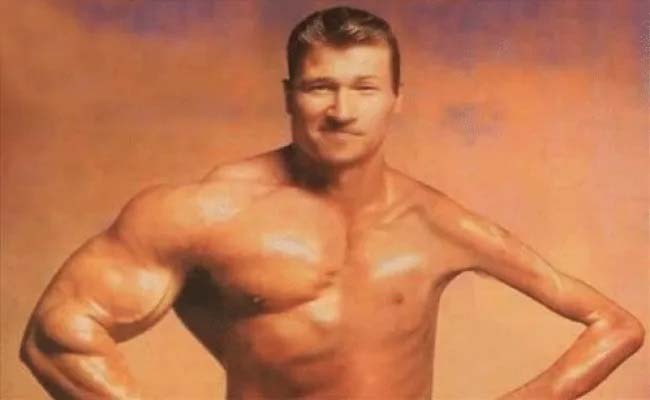
Spinal pain is one of the most widespread problems recently, and the majority of people believe these are chronic conditions with no cure, often attributed to old age. They think the only treatments are to stay on painkillers until your stomach is ruined, or to have surgery. We have all seen relatives and acquaintances who underwent surgery, especially spinal surgery, only for the problem to worsen, or if it did resolve, it was only a temporary fix. After a few years, the pain returns, often more severe than before. In short, there is a belief that there is no solution.
This, of course, is a completely false belief. You can confirm this for yourself by reading this entire article to understand the problem, and then reading our article “Patients Who Recovered from Disc Problems” to see the success stories for yourself.
In recent years, thanks to physiotherapy, we have been able to understand why these problems appear and what causes them. Naturally, once we know the cause, the treatment becomes easier. This brings us to the important point:
What is the cause of spinal pain and problems?
The short answer is that your body is not balanced, and there is a lack of muscular balance. This leads to the more important question:
What does “muscular balance” mean?
To understand what muscular balance is, first look at these two images.
In the first image, you will see two skeletons. In the first one, both shoulders are on the same line, the right and left sides of the waist are on the same line, the knees are opposite each other on the same line, and finally, the heels are aligned. In short, this means your entire body, from the front view, is balanced. Every bone is in its place, and the muscles on the right half of the body are balanced with the muscles on the left half. This is why this skeleton would have no pain.
This is in contrast to the second skeleton, where each bone is in a different position than its counterpart on the opposite side. This will ultimately lead to pain in most of the body’s joints because, in this state, the body is like a large engine where, instead of all the gears moving smoothly and in harmony, they are now grinding against each other. In this case, the body will complain in its own way: by producing pain to make you stop moving.

second photo

In this next image, you’ll find that the first skeleton, labeled “balanced,” has a spine with gentle curves. A line coming from the top runs through the center of the lumbar vertebrae and lands exactly in the middle of the thigh. You’ll notice this same line is different in every other skeleton; it might be behind the thigh, either slightly or significantly. You’ll also see that the gentle curves of the spine are either greatly exaggerated or have disappeared. This means the front and back muscles are not in a state of balance, and you will also feel pain as your body begins to complain.
There are three elements we use to assess muscles to determine if the body is balanced:
Strength: The strength of the muscles on the right side must be the same as the strength of the muscles on the left side. The strength of the muscles in the front must also equal the strength of the muscles in the back.
Muscle Tone: This is the degree of hardness or “rock-like” feeling in a muscle. People who complain of neck pain will know this well, as they often find their shoulder muscles are stiff and feel like stone. This is the opposite of conditions like paralysis, for example, where the muscles are initially limp, almost like jelly. Ideally, the muscle tone in the front, back, and sides should be moderate and equal to prevent problems and pain.
Muscle Length: Many will be surprised to learn that muscles can shorten. You are born with a normal muscle length, but as a result of prolonged incorrect posture, they can shorten. The proof of this is if you see a child whose arm was broken at the elbow and put in a cast for a period; they often can’t straighten their arm afterward. This is due first to stiffness and second to the fact that the bicep muscle has shortened. So you don’t get the wrong idea, as physiotherapists, we don’t use a tape measure to assess muscle length. Everyone’s body is different, so the measurement is done through tests during the examination to judge if a muscle is at its normal length or not. You can search for this topic on Google using the term “muscle length test.”
What causes a muscle to shorten is that, over time, with poor posture, the muscle fibers lose their elasticity and begin to adopt the same position the person works in for hours every day. If you’re still surprised that muscles can shorten and their properties can change, I’ll give you a simple analogy that might clarify the idea.
When you buy meat (which is muscle), you are careful to get meat from a young animal. Why? Because young meat is tender, which means its muscle tone is balanced. Young meat also doesn’t shrink much when cooked, meaning its elasticity is excellent and it hasn’t shortened. This is in contrast to tough, old meat, which shrinks and becomes chewy and tough when cooked.
The bottom line is that the properties of muscles change. And of course, if any muscle in the front, back, or on the sides changes its properties and shortens, a problem will occur, the position of the bones will change, and you will start to feel pain.
I think you are now beginning to understand what muscular balance and a balanced body mean. If you’re still not entirely clear, the following examples will clarify it further. Every joint in our body must have balanced muscles around it so that the joint can move easily without any hindrance. An imbalance can occur in a single joint, several joints, or the entire body. All of this will be explained in detail in upcoming articles and episodes, God willing.
Our first example of muscular imbalance:
Upper Cross Syndrome
If you search for “Upper Cross Syndrome” on Google, you’ll find over 70 million articles (look at the highlighted number in the next image). You can search for any term or problem I mention in the same way.

To understand Upper Cross Syndrome correctly, look at the next image.
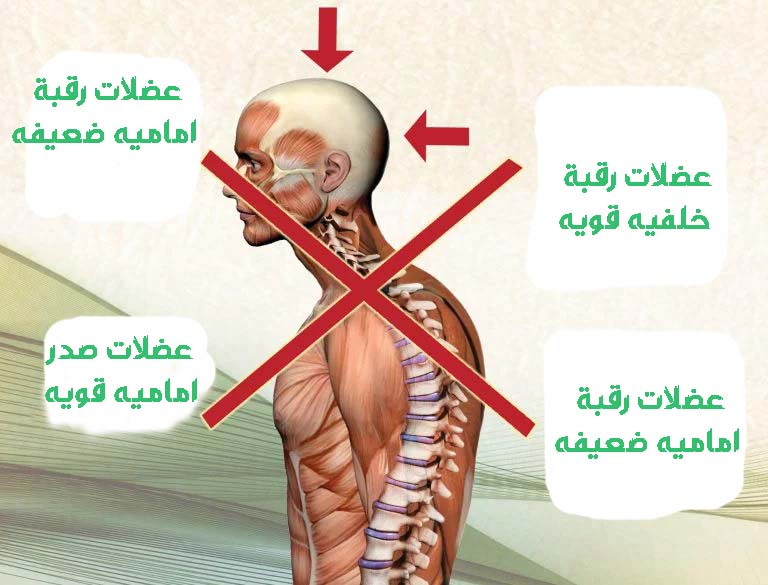
In Upper Cross Syndrome, as shown in the image above, you’ll find that the deep front neck muscles are weak, and the back neck muscles are very strong and tight. The muscle tone in the front muscles is low, while in the back, it is very high. This is why most people who complain of neck pain feel that the muscles at the back of their neck are rock-hard.
The same applies to the chest muscles, which are strong and tight, while the mid-back muscles are very weak. This leads to a slight hunching of the back. Of course, anyone with this syndrome will likely show disc problems and arthritis (especially arthritis) on their scans. They can take all the painkillers in the world, but the pain won’t go away because the problem lies in the muscles. Even if they have surgery, the situation won’t improve much, or if it does, it will only be for a short period before the pain returns. This is why we say the solution is not surgery or medication. Surgery is reserved for specific cases, which I will discuss in detail later.
I have already discussed this syndrome in a detailed video and article, which you can view here.
Straightening of the Cervical Spine (Flat Cervical Curve)
In cases of a straightened cervical spine, you will find that the natural curve of the neck has completely disappeared. In this case, the problem is likely a herniated disc, and everything is the opposite of the syndrome above: the weak muscles become strong and tight, and the strong ones become weak. The patient will complain of all the symptoms of a herniated disc: pain, blurred vision, difficulty sleeping, and more. I have also discussed this problem in its own episode, which you can watch here.
If you look at the next image, you will see the difference between a normal neck curve and what happens when that curve diminishes, leading to the onset of neck pain, arm pain, numbness, blurred vision, jaw pain—a whole host of problems. Yet, most people ignore the root cause and seek the wrong treatment, either with medication or painkillers, which ultimately yields no results. Most patients live with this pain for a large part of their lives. I have explained this problem in a video and an article about cervical disc herniation, which you can view here.

Lower Cross Syndrome
Naturally, if there is an Upper Cross Syndrome, there will also be a Lower Cross Syndrome. This involves a muscular imbalance just like the one above, but in the waist and lumbar spine region. First, look at this image.
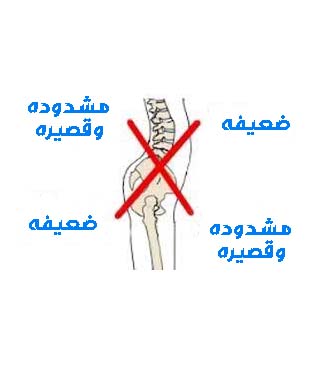
Image Caption: Muscular Imbalance
This means your back muscles are strong and very tight (contrary to what you might think), while your abdominal muscles are weak. The opposite is true below: your posterior hip muscles are weak, while your anterior hip muscles are strong and tight. We will talk about this problem in detail in future videos and articles, but I want to share a small detail.
First, orthopedic doctors often call this condition spinal arthritis (spondylosis). As physiotherapists, we call it Lower Cross Syndrome. Both are correct. Physiotherapy evaluates it from a muscular perspective, while orthopedics evaluates it from a skeletal perspective, hence calling it arthritis.
The more important and critical detail is that this problem is characterized by one key symptom: pain that appears when the patient walks or stands and disappears completely as soon as they bend forward or sit down for a minute. The pain then goes away, and they can walk or stand for a while until it returns, forcing them to bend over or sit again. This cycle continues whenever they are tired.
We will discuss this problem in detail in its own episode and article. Follow us on our page and website.
Straightening of the Lumbar Spine (Flat Back)
A flat back also occurs due to a muscular imbalance at the level of the pelvis and lumbar spine. Here, everything is the opposite of Lower Cross Syndrome. Look at the next image.
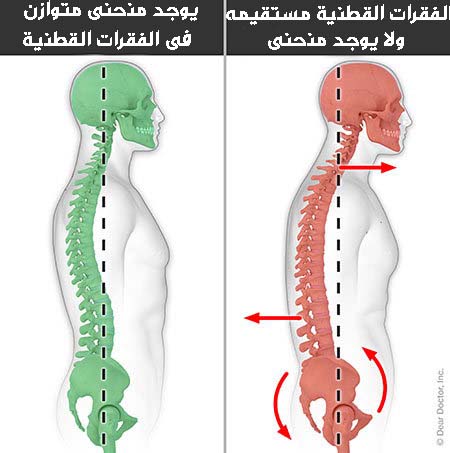
Here, you will find that the natural curve that should be in the lumbar spine has disappeared and become straight. This is a result of the abdominal muscles shortening and becoming stronger than the back muscles. The opposite is true below: the anterior pelvic muscles are much weaker than the posterior pelvic muscles. In this case, the curve of the lumbar spine will change and disappear.
This is when a herniated disc occurs, and its symptoms are well-known, including leg pain (either in the front or back, which we call sciatica), numbness, and back pain. We have discussed all of this in detail, and you can see the article and episode here.
Scoliosis (Lateral Curvature of the Spine)
This problem is different from most of the others mentioned, such as arthritis, herniated discs, or cross syndromes. All the previous conditions involved an imbalance between the front and back muscles.
This time, there is an imbalance between the right and left side muscles, along with the front and back muscles. Scoliosis is a very significant problem, and its treatment takes a long time, from 6 months to a year. There is a specific degree of curvature, and if it is exceeded, surgery becomes necessary. Most cases of scoliosis occur in girls, especially young ones; it is rare in boys. The incidence ratio is 9:1—for every ten cases, there will be one boy and nine girls. We will discuss this in detail in an upcoming series of episodes and articles.
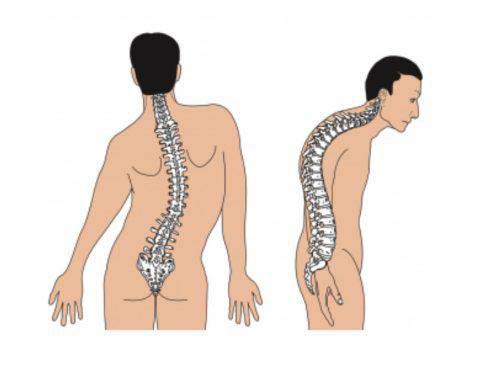
Image Caption: Scoliosis, Curvature of the Spine
Rounded Shoulders
The problem of rounded shoulders occurs due to an imbalance between the front chest muscles and the upper back muscles. The result is a rounding of the shoulders. This, of course, happens to everyone who works for long periods sitting at a computer, those with desk jobs, or even those who go to the gym and strengthen their front chest muscles more than their back muscles.

Image Caption: Rounding and Hunching of the Shoulders
The problem occurs when the tendon inside the shoulder, called the supraspinatus tendon, gets compressed by the prominent part of the shoulder blade (acromion) because the scapula’s position is incorrect. The result is shoulder tendonitis at first. If the problem persists, a tendon tear will occur. If the problem continues without physiotherapy, a complete tear of the tendon will happen, at which point surgery is necessary, followed by physiotherapy.
I will also talk in detail about shoulder problems in the future.
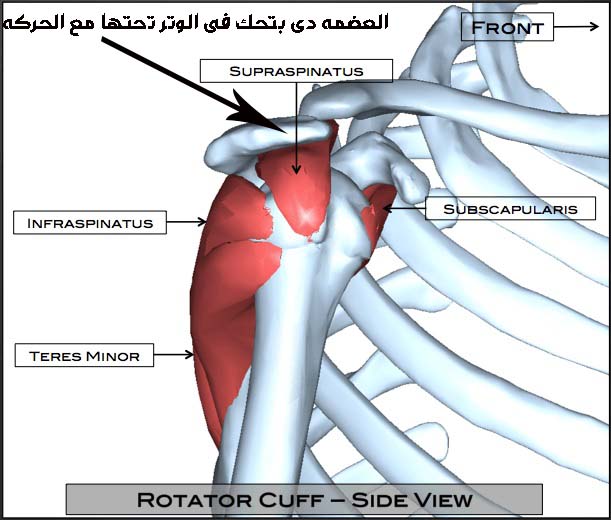
Image Caption: Shoulder Tendonitis
Knee Osteoarthritis and Knee Cartilage Problems
Of course, among the most important problems that result from this imbalance are knee problems and knee pain, especially osteoarthritis and cartilage issues. Normally, the knee should be on the same line that runs from the hip to the second toe of the foot so that weight is distributed correctly through the knee, like in this picture.
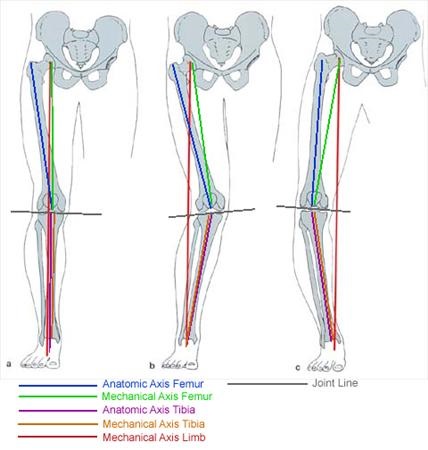
Image Caption: Knee Alignment Line
- In the first picture, the line is correctly aligned from the hip to the knee to the toes.
- In the middle picture, the knee goes inside the line (knock-kneed), which means pain and arthritis on the outer side of the knee.
- In the last picture, the knee goes outside the line (bow-legged), which means pain and cartilage issues on the inner side of the knee.
As physiotherapists, we can treat this by balancing the front and back knee muscles along with the hip muscles, but only up to a certain angle of deviation. If the deviation exceeds that limit, surgical intervention is better. Of course, I will also talk about this in detail in future episodes and articles.
Also, to prevent this article from becoming too long, I will later discuss problems of the foot, elbow, and most of the body’s joints from a physiotherapy perspective.
The last thing I will say in this article, dear reader or patient, is that these are not my words. These are the words of a professor and neurologist who couldn’t find the answers in his own field and was puzzled as to why people suffer from pain and get herniated discs in the first place. He decided to delve into physiotherapy to discover the root of the problem. Indeed, he was able to conduct experiments on over 20,000 patients until he found the solution. This doctor’s name is Vladimir Janda.
I hope that you have understood, even if just a little, what muscular balance means. Watch the episodes and read the other articles to better understand your problem and its treatment, and to escape the suffering that most people endure.
Are there cases that recover through muscular balance?
You can see our article “Patients Who Recovered from Disc Problems” if you want to see cases that healed without medication or surgery. Watch the videos, then read the reviews. This is just a small number. If you want to see more, you will find all our patients on our Facebook page sharing their opinions after and during their sessions. You can go see for yourself how they returned to their lives without medication or surgery.
Finally, if you have any problem, contact us.
Cairo Branch: Nasr City, 53 Hisham Labib St.
For the detailed location, click on the word “Location”.
To book or inquire by phone, click the blue button to reveal the phone number.
Cairo Phone Number
Mansoura Branch: Mansoura, in front of Al-Salam Mosque.
For detailed directions, click on the word “Directions”.
To book or inquire by phone, click the green button to reveal the phone number.
Mansoura Phone Number

